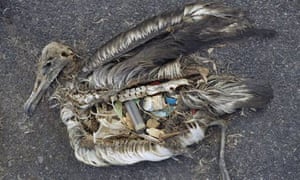Waste Green living blog
Which is the bigger eco-villain: plastic or paper?
Plastic is held up as a symbol of the environmental damage of disposable culture. But does it deserve its bad reputation?
Disturbing pictures of dead seabirds with lighters, bottle caps and plastic bags in their guts are among the images that have contributed to plastic's bad reputation. But research by Oregan State University published this week suggests that the size of the "great garbage patch", an accumulation of plastic debris that floats in the Pacific, has been "grossly exaggerated". Rather than being twice the size of Texas, as is commonly reported, studies suggest the "cohesive" patch is less than 1% of the size of Texas.
Clearly, plastic does pose a threat to wildlife. But has its status as an environmental villain been exaggerated? Many of the world's most potent environmental threats are invisible, but plastic loiters in trees and riversas a reminder of the consequences of our consumption. However, in some cases, plastic is environmentally the better option.
For example Riverford Organics, one of the largest vegetable box schemes in the UK, discovered that swapping short-lived cardboard boxes for more durable plastic ones could reduce the company's carbon footprint from packaging by 70%. There was one problem. "Our customers hate plastic with a vengence," the company's website says. Even though paper and cardboard are responsible for 85% of the carbon footprint from packaging, virtually all complaints are about the plastic punnets and bags, which are responsible for only 8% of the footprint.
Guy Watson, the founder of Riverford, was prepared to make the investment in plastic boxes, but decided to test the water with a customer survey last summer. Around third of respondents were "pretty vehemently opposed" to the change and as a result, the company bottled out, concerned that plastic boxes would put off new and existing customers who think plastic is environmentally unfriendly and ugly. "You have to be quite courageous to fly in the face of people's intuitive judgement," he says, "and some might say commercially foolhardy."
Watson is unwilling to take that risk at the moment, but says he'd "be surprised if we don't have plastic boxes within five or 10 years". Meanwhile, the company is investigating the possibility of using bamboo.
Other retailers have had more success in switching to plastic. Marks & Spencer now uses the material for its 25cl wine bottles and will trial plastic for full-sized bottles this spring. The supermarket introduced the new bottles because less energy is required to manufacture them than a glass bottle, and the lightweight bottles reduce the distribution carbon footprint. There were no reported complaints, with customers apparently enjoying the lighter weight.
So is the future plastic fantastic? Julie Hill, author of the forthcoming book The Secret Life of Stuff, says that plastic has environmental potential because it is very durable, adaptable, flexible and light. Plastic's durability, for instance, means it can have a lower impact (if re-used, as Riverford had planned) than materials such as cardboard, despite the fact that plastic has two to three times more embodied carbon than paper and card.
Unfortunately, Hill says, plastic's potential is often unfulfilled: plastic products are frequently used only briefly and thrown away. According to the government's Waste and Resources Action Programme, 85% of local authorities in England collect plastic bottles, and only 26% collect other rigid mixed plastics. If plastic is allowed to escape into the environment it is a hazard as it mostly doesn't biodegrade.
Ultimately, it all depends on how a material, whether plastic or paper, is used – and what happens at the end of its life. Plastic pollution such as the "great garbage patch" of the Pacific may capture our imaginations, but plastic's bad reputation is not always borne out by the facts. Just because a brown cardboard box looks greener than plastic, that doesn't mean it is.
Which is the bigger eco-villain: plastic or paper? | Sylvia Rowley | Environment | The GuardianRiverford has its green webpages:
Packaging - Riverford
Riverford has worked with the University of Exeter:
Sustainability - Sustainability - University of Exeter
And here is Guy Watson, founder of Riverford, writing in the Telegraph a couple of years ago:
A few years ago we worked with Exeter University to measure the carbon footprint of our veg box business as a whole. Many of the results were counterintuitive - for example, plastic packaging commonly has a lower carbon footprint than paper, and degradable plastics are normally bad for the environment as, less surprisingly, are many biofuels.
We created a website to share our conclusions and have used the information to guide some of our decision-making; partly for ethical reasons and partly because I expect, at some point in my life, that the price of depleting fossil fuels will eventually force business to restructure and change to survive. I would rather be ahead of the game. One day I hope to have the courage and cash to challenge our customers' understandably intuitive loathing of plastic and move to a deposit-carrying plastic box, because the carbon footprint of the cardboard veg box that we currently use (even though it is made from 98 per cent recycled materials, and is reused up to ten times and then recycled) is still almost as large as the trucks that move them around the country.
Guy Watson: why UK-grown fruit and veg isn't always best - Telegraph.
.
.


No comments:
Post a Comment